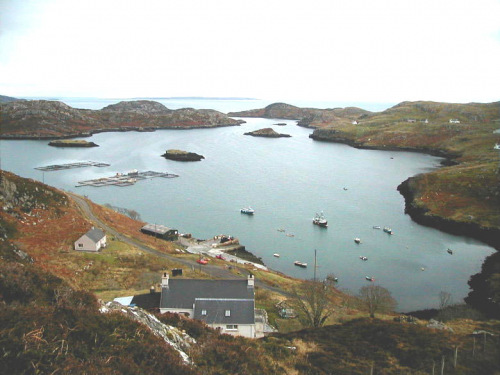Marvig
Marvig is a village of 24 crofts on Loch Marvig, just south of the mouth of Loch Erisort.Marvig, similar to the other villages in Park, was evidently at one time wooded, as the roots of trees are to be found in nearly all the holdings. In the centre of the village is a hill called “Cnoc na h-airigh” (hill of the shieling) which got its name from the shieling on the top of the hill where the shepherds once tended stock belonging to the Ranish tacksman.
When the Park clearances took place, some of those who were evicted settled in Marvig dividing it up into 21 holdings. At that time, the ground was covered with heather to the shore, but today, through cultivation, not a brush of it is to be found there.
The settlers came from round Loch Shell and Buthnish. There were also some of Irish extraction from a smack captained by a Patrick Smith and trading in selling cloth and making suits for men and costumes for women. In later years, an Irish tailoress name Anabella Naylor made her home in a small “bothan” near the shore.
Oats and barley were grown and the grain was ground into meal by hand stones and later by water-power, as was the case in all the villages.
At that time, cod and ling were very plentiful in the Minch and at one time over 40 boats were engaged in hand-line fishing out of Marvig. There were three curing stations and a salting house in operation. The Shiant banks were famous at that time for white fish. Skate which had been caught, were very often left in piles on the fore-shore for anyone to take away.
When the south-west wind blew, a lot of tacking was necessary before the boats could reach the stations from the mouth of the loch. One housewife in particular would begin grinding the grain as soon as her husband’s boat appeared at the mouth of the loch and she was sure to have the bannock ready by the time he arrived home.
The ‘splitters’ were expert in removing bones from the fish and one fellow was so proficient in filleting that he would remove the bone with two strokes of his knife, throw it up in the air and have the next one out before the first reached the ground. The stations were owned by a Stornoway curer, Alexander MacKenzie, who had as his foreman one Peter Miller. The curing ended about 1875.
There was no school in Marvig for some time after being settled in and those desirous of some education attended a Gaelic class in Cromore. A thatched building was erected about four feet from the fore-shore beside the salting house and here one John MacLeod and later C MacKenzie (both catechists) taught till the Planasker School was built. The school roll peaked at 120 and in 1953 was 11.
Booklet available.
Marvig genealogy on Hebridean Connections.
